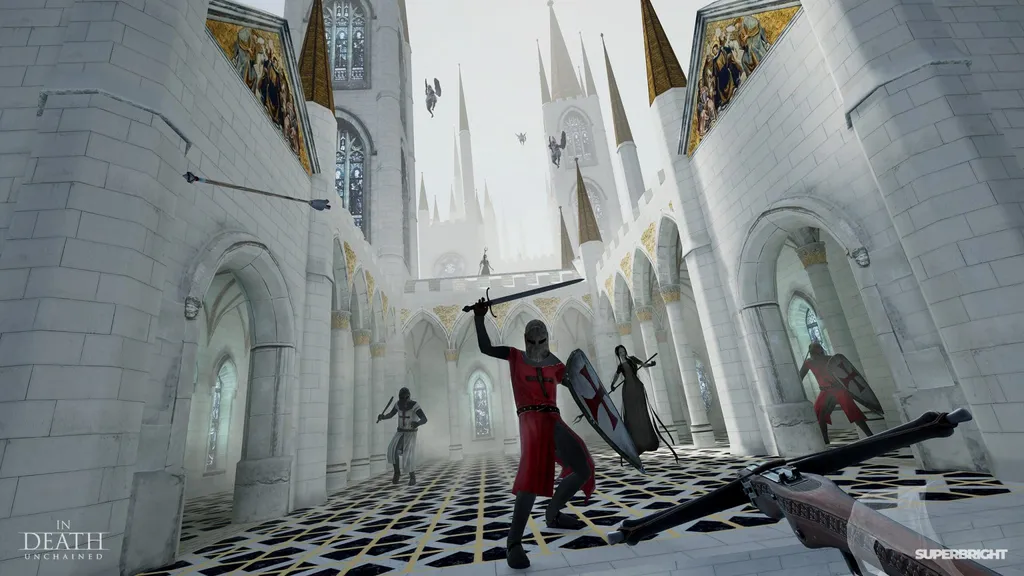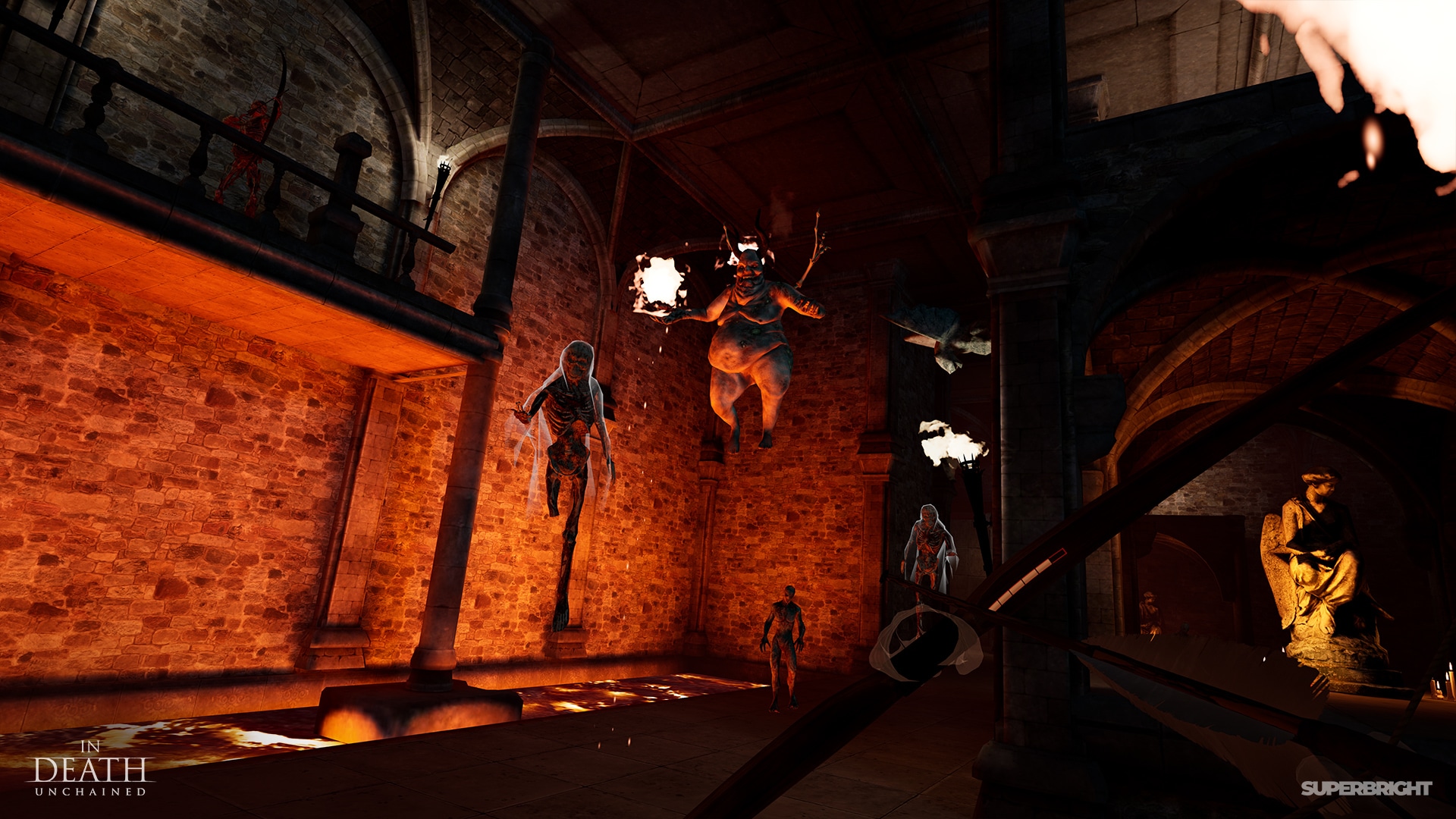Get ready to go back to hell this week, and this time it’s wireless!
Yup, In Death: Unchained hits Oculus Quest on July 23rd. Unchained sports a brand new, exclusive level for the VR roguelike, which finds itself in the hands of new developer Superbright. We spoke to Wojtek Podgorski, Superbright CEO, about the ambitious port. Below, he speaks to the challenges of getting the game to fit onto Quest, and what the studio’s plans are for the future.
How did Superbright come about to be working on In Death?
We’ve loved the original ever since it came out. We spent a lot of time playing it but it always felt like it would tremendously benefit from wireless play. Once the Quest was announced, it felt like it’s genre and its replayability were a perfect fit for the headset, and that was still from the fan’s perspective of the game.
Our friends at Solfar approached us about helping them to bring In Death to Oculus Quest, and over time that has evolved into much more than that, it really always felt to us like the game deserved to have more than “just” a port, and it felt like Oculus’ interest in bringing it to Quest would help make such changes possible.
Very early we had a clear vision of what we wanted to do, and Solfar were not just supportive but encouraging of these changes, and so was Oculus, who truly was an amazing partner throughout the process. We were still talking it over when Solfar changed their company’s course and set off on their new adventure outside of VR and it became clear if it wasn’t going to be us, and focusing on Quest, then In Death would not get a new life in any form. Everything else happened very naturally, and with Solfar’s blessing and Oculus’ support we set out to make In Death: Unchained happen on Quest.
What exactly has changed about the game for the Quest release?
It would actually be pretty hard to answer “exactly”, because a lot has changed, while retaining what players loved about the game.
The most obvious difference of course, is the whole new world called The Abyss but also unlocks after a certain level of game progression. It’s hard, it’s intricate, it’s in your face, and it was built by Superbright from the ground up for Quest. It includes new enemies, designed to challenge the players in new ways, it has two new Pits – these optional areas with high risk/reward factor for the more adventurous gamers. Oh and The Abyss ends in what we believe is the toughest, most exciting boss fight in the game. It also continues the trend of procedural generation and actually offers even more replayability than the first two original worlds.
We have a completely new tutorial that fills in a few gaps and we’ve made calculated adjustments so the game is more welcoming to new players early on, where previously they could get overwhelmed too quickly without getting to a point where they understood dying is part of the game.
Most importantly the game adapts to the mobile headset format of play by adding the ability to save sessions mid-game. We’ve fixed a ton of small UX annoyances. We’ve also rebuilt the code behind teleporting to make it way more reliable – gone are the moments of frustrations where the teleport fails for no reason. The shard has also been modified to have a clearly different use from regular teleport now. The shield works more reliably. You get notified when you get a new achievement. You get a really awesome weapon skin as a reward for beating each of the game’s bosses for the first time. And then there’s a laundry list of tweaks under the hood so it’s difficult to name them all without making a wall of text. All in all, a lot of effort has been given this game, both originally by Solfar and now by us.
How does the game benefit from the wireless nature of Quest?
So the lack of cables and inside-out tracking are by far the two biggest benefits for a game like this.
For games like Beat Saber, where you’re facing one direction, having no wire is a much, much welcome but bonus comfort. For a game like In Death it’s a necessity – when you’re changing directions drastically and frequently (and can find yourself in surprising locations in your house afterward), when the enemies and their arrows come from every direction and angle, it’s a massive feature.
This type of game needs to track you correctly regardless of the position and direction you’re facing in real life and these parameters shouldn’t affect your gameplay, your fun or your immersion. When you play freely, instead of standing statically to not mess up the cables or the tracking, you become the weapon. And the game can become a bit of a workout 🙂
Also, since one run in the game can potentially last hours, especially if you’re a more careful player, having the option to stop playing and just pick it up the next day to be back in the game in a matter of seconds is a big deal. It’s what mobile devices do, but it wasn’t really an option in the original. So we’ve added the ability to save the game state mid-run while also keeping the game fair (you can’t just save before the boss fight, lose and try again in a game with global leaderboards). But for this we needed to remake a ton of code, and as any developer will know, adding game saves to an existing code base can be incredibly challenging, but now, true to the headset’s mobile nature, you can just start “one more level” knowing you don’t have to finish it in one go.
Was it a challenge to get the full experience working on the headset?
Oh boy, where to begin. It’s been incredibly intense, mainly because we were juggling on multiple fronts all at the same time – the original, adding all our own extra content, optimizing it all, and then finally making a ton of improvements and tweaks.
Ultimately, we have the same number of “stuff” on screen at the same time as on the PC and more than in PSVR, including the enemies, old and new, even more types of arrows, more environment building blocks, everything. I’m incredibly proud of the team and what we’ve been able to do, especially since, like in every ambitious endeavor, you have these moments of doubt.
Because right out the gate the question was just how much of the original we could even retain? Have we bitten more than we can chew? It’s a resource hungry game with its large, outdoor procedural environments often all visible at the same time, it has many dynamic, animated enemies spawning and shooting projectiles at you etc. And then there’s the distinct heavenly look which used a lot of post-processing and layering on the PC that you just can’t do on mobile. And so now we had to get all this working at 72 fps on a mobile device, in UE4.
All this effort required and was made possible because of a major technical push across the whole pipeline. We modified Unreal Engine quite extensively throughout development, including things like how emissive colors work in the engine. We’ve rebuilt or optimized every single asset in the game and built an automated pipeline that basically reconstructs the game from smaller pieces multiple times a day. We’ve re-engineered Solfar’s procedural generation and implemented our own to make The Abyss even more diverse both visually and gameplay-wise.
I’ve told them this in private multiple times, but I feel now is a good moment to publicly thank all the people at Oculus for being fantastic partners on this. Together with them, our team was able to accomplish something that on the technical side, is nothing short of amazing and I’m so proud and thankful to them that we pulled it off together.
Will older versions of the game be seeing any of these updates?
At the moment no. As I’ve explained we were already juggling multiple flaming balls to even bring it Quest altogether, and it was not only simply impossible to also update the other versions at the same time, but also many of the changes we had to or wanted to make for this to be a great Quest title, just didn’t work on the other platforms.
The products diverged early, and not only in obvious ways, and it’s not “In Death by Solfar” but “In Death on Quest by Superbright” now. The ability to focus on Quest was what made it possible in the first place. We love Quest, we think it’s the first true consumer-ready headset, it’s the future and this is where the game plays the way it’s been meant to be played.
What’s next for Superbright?
In the short term, it’s all about the In Death: Unchained release along with our plans to keep supporting it with updates and talking with the community, which is already bearing fruit because we’re making changes based on their feedback, including optional free locomotion.
Most excitingly for the game, we’re planning a DLC for Halloween. It’s something we’re really pumped about. Developing Unchained was about juggling on multiple fronts, but with the DLC we can focus on using all of that knowledge, all the little tricks and ideas we learnt and just focus on creating new content.
Beyond this, we have some ambitious concepts we’ve been prototyping for a while. Getting actual real-life experience with making a Quest release was one of our motivators before going for some really ambitious projects. So with Unchained under our belts and having a great relationship with Oculus we’re really looking forward to making bigger splashes in the future.



























